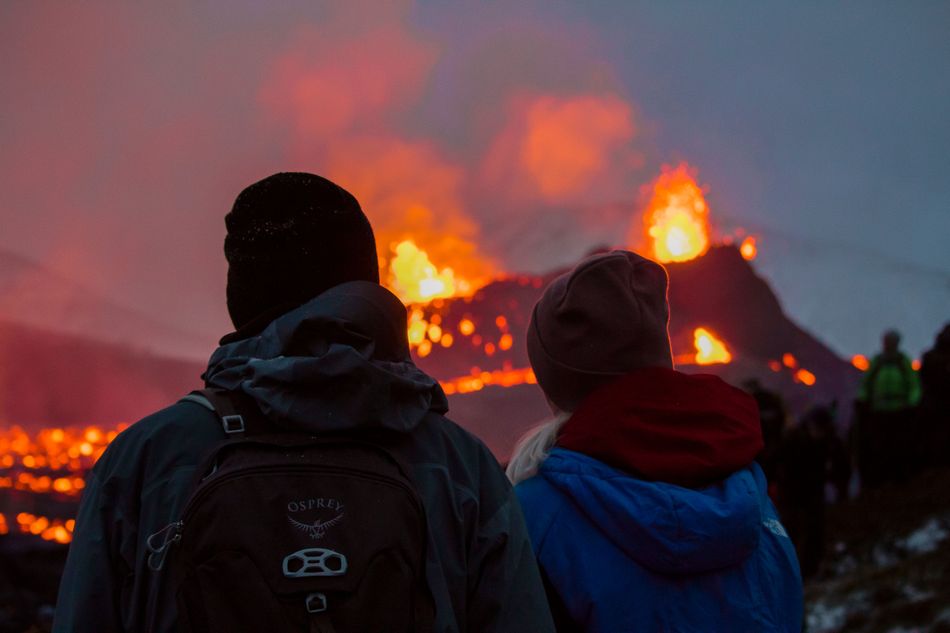Icelanders recently played volleyball as lava poured from the ground behind them.
Why so carefree? The new Icelandic eruption is relatively small and non-threatening for a volcanic eruption. And thanks to a well-placed webcam, it’s a fascinating natural event you can freely stream online as lava oozes from the ground.
“For the most part it’s relatively tame,” explained Jess Phoenix, a volcanologist and executive director of the environmental research organization Blueprint Earth.
Yet, even a tame event involving oozing and fountaining lava is a wondrous natural show, particularly the vivid red-orange glow at night. “Volcanoes are more glorious than the best Fourth of July fireworks display,” said Phoenix.
The eruption started on March 19 when a new fissure 500 to 700 meters (1,600 to 2,300 feet) long opened in a valley on the island’s Reykjanes peninsula. It happened in an area called Geldingadalir near the volcano Fagradalsfjall. There, molten rock flowed up through Earth’s crust. For Icelanders, it was exciting, not least because this southwestern region hadn’t seen an eruption in some 800 years. To boot, the lava didn’t threaten any communities. “YESSS !! , eruption !!,” the Icelandic musician Björk wrote on Instagram. “we in iceland are sooo excited !!! we still got it !!! sense of relief when nature expresses herself !!!”
Instead of closing #geldingadalir area, a huge team has been working on making it ‘safe’ for visitors by making paths, putting up a mobile connection, making site specific weather forecasts and having rescue teams wearing gas sensors onsite, ready to help in case of emergency. pic.twitter.com/iy0mLmCdmr
— Kristín Jónsdóttir (@krjonsdottir) March 27, 2021
But an eruption itself in Iceland is not unique. The entire island is composed of different types of volcanic rock. Iceland has been forged by eruptions, and new earth, in the form of molten rock, now continues to spill from the ground and at one point formed a tall cone of lava (called a spatter cone). The island lies where two of Earth’s great tectonic plates (the North American and Eurasian plates) meet in the Atlantic Ocean, called the Mid-Atlantic Ridge. The plates are moving apart from each other, and below Iceland a plume of molten rock rises up from this geologically dynamic zone — and sometimes erupts onto the surface.
Some eruptions are explosive, like in 2010 when Eyjafjallajökull blew enough ash into the air to close some 300 airports in Europe for about a week. The eruption canceled over 100,000 flights. But this latest eruption is different. The molten rock coming from some 17 to 20 kilometers (10 to 12 miles) beneath the ground has a significantly different makeup (specifically a lower amount of sticky silica), which means the molten rock can flow or ooze. “It’s oozy and runny,” explained Phoenix. “It’s like what we see in Hawaii a lot of the time.” (These types of flows are called “pahoehoe flows,” named for these very flows in Hawaii.)
In contrast, when magma is much stickier, with a higher silica content, the molten rock tends not to flow. It stays underground and can build up enormous amounts of pressure and heat — sometimes resulting in violent, explosive eruptions, like the Mount St. Helens eruption in 1980.
Watching the pahoehoe lava ooze out (from a reasonably safe distance) is fascinating, and surely part of the draw.
“Being at the margins of a pahoehoe flow I always find it compelling to take countless images and videos of ropey pahoehoe being formed,” said Stanley Mertzman, a volcanologist at Franklin and Marshall College. “That never gets old because you think the next image or video will be better, more dynamic than the last.”
Near the eruption, it’s not just about seeing the lava. It’s also about listening. When this lava cools, a natural glass forms on the surface of the flow. It flakes off as the lava cools. “You can hear the tinkle of the glass shards,” marveled Mertzman. And a little drizzle or rain can sizzle on the lava, too. “The sizzle sound can be quite striking,” he said.

People taking in the volcanic glory.
Image: Marco Di Marco / AP / Shutterstock
What comes next is unknown. The eruption could keep gushing lava for months or longer. Or it could stop now. “There isn’t a good idea of what happens next,” said Phoenix, but noted volcanologists are vigilantly taking samples of the lava and air to glean hints of what the eruption has in store. In theory, the new eruption could continue and eventually grow to be a big volcano, over the course of millennia. Or not.
For now, the volcanic thrill continues.
In a time-lapse of the eruption one evening, the activity appears to die down a bit, before picking up steam. “It seems the outflow rate of lava increases, like the gods open the spigot wider,” said Mertzman. “Pretty cool.”
